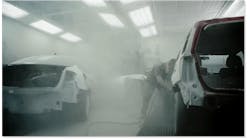If something is expensive to buy, it’s probably more expensive to repair. As of late, this certainly applies to EVs. According to a 2023 yearly review by Mitchell, the average U.S. repairable EV severity was $6,018, compared to their ICE counterpart, it’s $4,696.
The topic of repair costs for EVs was highlighted in an extreme anecdotal example where Tesla-centric YouTuber, Ryan Shaw, says a fender-bender that damaged his rear bumper resulted in a bill of over $8,700. In a second rear-end collision, his Tesla was so severely damaged that it could not drive away. The cost of completely repairing the car came close to $24,000.
Why are the costs so high? Will it get cheaper at some point? Is it difficult to get certified?
We spoke with Kevin FitzPatrick, Opus IVS senior vice president of North America operations, to learn more.
Why is EV repair so expensive?
“Number one, it’s the [limited] number of facilities repairing EVs. I think that’s one of the biggest factors,” FitzPatrick said. “The other factor is the number of recycled parts that are available to repair these vehicles and the [low availability] of aftermarket parts. Those are the three main factors if we’re going into the costs.”
He emphasized that there’s a lack of options for parts manufacturers given how new EVs still are.
“Tesla, for example, is the manufacturer for most of the parts which leads to longer cycle times in most cases. Anything involving the battery is an instant total.”
FitzPatrick also shared that that repairers often sublet the disarming of the car to a professional to make the EV safe to repair. “In other words, fuses are actually pulled, and the car is brought to a condition where other technicians can put their hands on the vehicle.”
How is the market responding to the high cost of EV repairs?
“Getting more technicians, getting more training,” he said.
He also emphasized the need to increase in the number of qualified and certified technicians so consumers will have more options, therefore boosting competition.
Later, he said that there has been a notable increase in collision repair centers that cater to EVs, but only by a few percentage points. The reason why there was a slow increase, according to FitzPatrick, is because the demand for EVs by consumers is not growing as fast as many expected.
He also said more vehicle manufacturers are making their presence in the market known, which should eventually increase overall competition in the EV market and drive EV repair costs downward.
If consumer demand is a factor, then why is it so low in the U.S.?
“Unfortunately, the reality in the United States is that the infrastructure needed to support these vehicles didn’t grow as expected,” he said.
“The populace didn’t adopt them in the way the government wanted them to. Younger drivers are certainly adopting them at a much higher rate than older traditional folks such as myself.”
He also recalled the recent ‘deep freeze’ that swept across parts of the country, which exacerbated EV charging problems for owners and drivers.
Aside from the mechanical issues that would occur from meteorological events, the day-to-day ownership of an EV is not what people expected.
Things that FitzPatrick listed as other reasons that will deter those from adopting EVs include:
- The cost to charge an EV at public fast chargers can be high.
- The short shelf life of an EV tire.
- EVs tend to lose more resale value as a percentage compared to an ICE vehicle.
“There are still considerations to be had when adopting EVs as your main mode of transportation.”
Is it easy to get certified?
“Technicians have to take time out of their shop to get training and certified on the repair of these vehicles,” FitzPatrick said. He also emphasizes the safety aspect, which leads to the subletting.
“It’s not a tremendous amount of time. Most of the training takes 30 to 40 hours.”
Is there a projected growth as to how many EV certified collision repair centers will come up or be open considering the demand being lower than what was projected?
“I think all the manufacturers in the U.S. have throttled back on their build projections and I would expect a lot of our larger MSOs to follow suit on what their projections were.”
Despite the low consumer demand, is it still a good idea to get certified and get training?
“I think so,” FitzPatrick said. “It’s a growing vehicle population in any state.”
“I think you have to look at the ballpark for your particular business. If you’re in a metropolitan area, this is something you need to address. Obviously, you should have addressed it already. If you’re in the Midwest or in a rural area, you probably have a little more time.”
“It’s something that every collision repair business owner is going to have to consider soon.”



